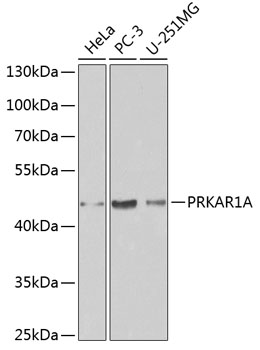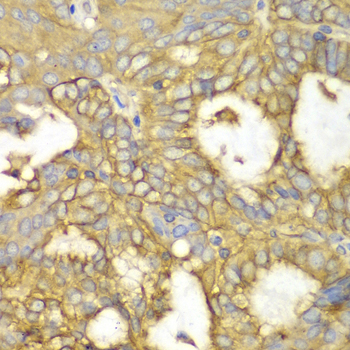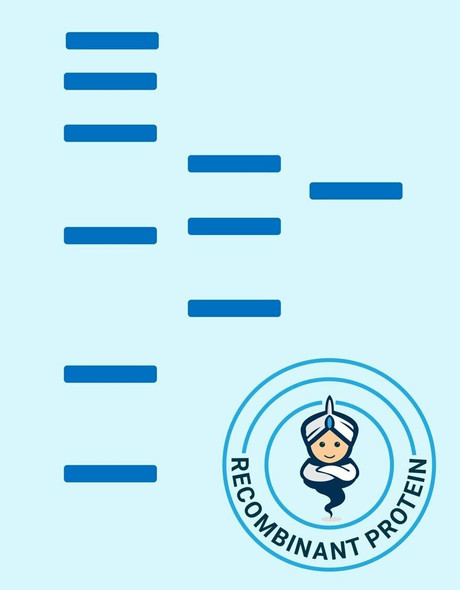Anti-PRKAR1A Antibody (CAB0906)
- SKU:
- CAB0906
- Product type:
- Antibody
- Reactivity:
- Human
- Mouse
- Host Species:
- Rabbit
- Isotype:
- IgG
- Antibody Type:
- Polyclonal Antibody
- Research Area:
- Cell Biology
Description
| Antibody Name: | Anti-PRKAR1A Antibody |
| Antibody SKU: | CAB0906 |
| Antibody Size: | 20uL, 50uL, 100uL |
| Application: | WB IHC IF |
| Reactivity: | Human, Mouse |
| Host Species: | Rabbit |
| Immunogen: | Recombinant fusion protein containing a sequence corresponding to amino acids 1-250 of human PRKAR1A (NP_002725.1). |
| Application: | WB IHC IF |
| Recommended Dilution: | WB 1:500 - 1:2000 IHC 1:50 - 1:200 IF 1:50 - 1:200 |
| Reactivity: | Human, Mouse |
| Positive Samples: | HeLa, PC-3, U-251MG |
| Immunogen: | Recombinant fusion protein containing a sequence corresponding to amino acids 1-250 of human PRKAR1A (NP_002725.1). |
| Purification Method: | Affinity purification |
| Storage Buffer: | Store at -20°C. Avoid freeze / thaw cycles. Buffer: PBS with 0.02% sodium azide, 50% glycerol, pH7.3. |
| Isotype: | IgG |
| Sequence: | MESG STAA SEEA RSLR ECEL YVQK HNIQ ALLK DSIV QLCT ARPE RPMA FLRE YFER LEKE EAKQ IQNL QKAG TRTD SRED EISP PPPN PVVK GRRR RGAI SAEV YTEE DAAS YVRK VIPK DYKT MAAL AKAI EKNV LFSH LDDN ERSD IFDA MFSV SFIA GETV IQQG DEGD NFYV IDQG ETDV YVNN EWAT SVGE GGSF GELA LIYG TPRA ATVK AKTN VKLW GIDR DSYR RILM GSTL RKRK MYEE FL |
| Gene ID: | 5573 |
| Uniprot: | P10644 |
| Cellular Location: | Cell membrane |
| Calculated MW: | 38kDa/42kDa |
| Observed MW: | 45kDa |
| Synonyms: | PRKAR1A, ACRDYS1, ADOHR, CAR, CNC, CNC1, PKR1, PPNAD1, PRKAR1, TSE1 |
| Background: | cAMP is a signaling molecule important for a variety of cellular functions. cAMP exerts its effects by activating the cAMP-dependent protein kinase, which transduces the signal through phosphorylation of different target proteins. The inactive kinase holoenzyme is a tetramer composed of two regulatory and two catalytic subunits. cAMP causes the dissociation of the inactive holoenzyme into a dimer of regulatory subunits bound to four cAMP and two free monomeric catalytic subunits. Four different regulatory subunits and three catalytic subunits have been identified in humans. This gene encodes one of the regulatory subunits. This protein was found to be a tissue-specific extinguisher that down-regulates the expression of seven liver genes in hepatoma x fibroblast hybrids. Mutations in this gene cause Carney complex (CNC). This gene can fuse to the RET protooncogene by gene rearrangement and form the thyroid tumor-specific chimeric oncogene known as PTC2. A nonconventional nuclear localization sequence (NLS) has been found for this protein which suggests a role in DNA replication via the protein serving as a nuclear transport protein for the second subunit of the Replication Factor C (RFC40). Several alternatively spliced transcript variants encoding two different isoforms have been observed. |
| UniProt Protein Function: | PKAR1A: a regulatory subunit of cAMP-regulated protein kinase. The inactive form of the enzyme is composed of two regulatory chains and two catalytic chains. Activation by cAMP produces two active catalytic monomers and a regulatory dimer that binds four cAMP molecules. Four types of regulatory chains are found: I-alpha, I-beta, II-alpha, and II-beta. Their expression varies among tissues and is in some cases constitutive and in others inducible. Interacts with RFC2: the complex may be involved in cell survival. Defects in PRKAR1A are the cause of Carney complex type 1 (CNC1). CNC is a multiple neoplasia syndrome characterized by spotty skin pigmentation, cardiac and other myxomas, endocrine tumors, and psammomatous melanotic schwannomas. |
| UniProt Protein Details: | Protein type:Protein kinase, regulatory subunit Chromosomal Location of Human Ortholog: 17q24.2 Cellular Component: protein complex; membrane; plasma membrane; neuromuscular junction; cytosol; AMP-activated protein kinase complex; cAMP-dependent protein kinase complex Molecular Function:protein binding; ubiquitin protein ligase binding; cAMP-dependent protein kinase inhibitor activity; cAMP-dependent protein kinase regulator activity; cAMP binding Biological Process: epidermal growth factor receptor signaling pathway; fibroblast growth factor receptor signaling pathway; nerve growth factor receptor signaling pathway; water transport; activation of protein kinase A; female meiosis; cardiac muscle cell proliferation; sarcomere organization; signal transduction; regulation of transcription from RNA polymerase II promoter; mesoderm formation; phospholipase C activation; negative regulation of meiosis; energy reserve metabolic process; innate immune response; renal water homeostasis; blood coagulation; regulation of insulin secretion; transmembrane transport Disease: Myxoma, Intracardiac; Carney Complex, Type 1; Thyroid Carcinoma, Papillary; Acrodysostosis 1 With Or Without Hormone Resistance; Pigmented Nodular Adrenocortical Disease, Primary, 1 |
| NCBI Summary: | cAMP is a signaling molecule important for a variety of cellular functions. cAMP exerts its effects by activating the cAMP-dependent protein kinase, which transduces the signal through phosphorylation of different target proteins. The inactive kinase holoenzyme is a tetramer composed of two regulatory and two catalytic subunits. cAMP causes the dissociation of the inactive holoenzyme into a dimer of regulatory subunits bound to four cAMP and two free monomeric catalytic subunits. Four different regulatory subunits and three catalytic subunits have been identified in humans. This gene encodes one of the regulatory subunits. This protein was found to be a tissue-specific extinguisher that down-regulates the expression of seven liver genes in hepatoma x fibroblast hybrids. Mutations in this gene cause Carney complex (CNC). This gene can fuse to the RET protooncogene by gene rearrangement and form the thyroid tumor-specific chimeric oncogene known as PTC2. A nonconventional nuclear localization sequence (NLS) has been found for this protein which suggests a role in DNA replication via the protein serving as a nuclear transport protein for the second subunit of the Replication Factor C (RFC40). Several alternatively spliced transcript variants encoding two different isoforms have been observed. [provided by RefSeq, Jan 2013] |
| UniProt Code: | P10644 |
| NCBI GenInfo Identifier: | 125193 |
| NCBI Gene ID: | 5573 |
| NCBI Accession: | P10644.1 |
| UniProt Secondary Accession: | P10644,Q567S7, K7ER48, |
| UniProt Related Accession: | P10644 |
| Molecular Weight: | 42,982 Da |
| NCBI Full Name: | cAMP-dependent protein kinase type I-alpha regulatory subunit |
| NCBI Synonym Full Names: | protein kinase, cAMP-dependent, regulatory, type I, alpha |
| NCBI Official Symbol: | PRKAR1A |
| NCBI Official Synonym Symbols: | CAR; CNC; CNC1; PKR1; TSE1; ADOHR; PPNAD1; PRKAR1; ACRDYS1 |
| NCBI Protein Information: | cAMP-dependent protein kinase type I-alpha regulatory subunit; Carney complex type 1; tissue-specific extinguisher 1; protein kinase A type 1a regulatory subunit; cAMP-dependent protein kinase regulatory subunit RIalpha; cAMP-dependent protein kinase type I-alpha regulatory chain |
| UniProt Protein Name: | cAMP-dependent protein kinase type I-alpha regulatory subunit |
| UniProt Synonym Protein Names: | Tissue-specific extinguisher 1 |
| Protein Family: | CD83 antigen |
| UniProt Gene Name: | PRKAR1A |
| UniProt Entry Name: | KAP0_HUMAN |








